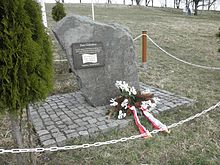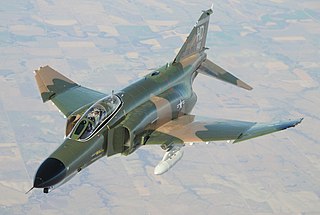
The McDonnell Douglas F-4 Phantom II is an American tandem two-seat, twin-engine, all-weather, long-range supersonic jet interceptor and fighter-bomber originally developed by McDonnell Aircraft for the United States Navy. Proving highly adaptable, it entered service with the Navy in 1961 before it was adopted by the United States Marine Corps and the United States Air Force, and by the mid-1960s it had become a major part of their air arms. Phantom production ran from 1958 to 1981 with a total of 5,195 aircraft built, making it the most produced American supersonic military aircraft in history, and cementing its position as a signature combat aircraft of the Cold War.

Francis Gary Powers was an American pilot whose Central Intelligence Agency (CIA) Lockheed U-2 spy plane was shot down while flying a reconnaissance mission in Soviet Union airspace, causing the 1960 U-2 incident.

The Lockheed U-2, nicknamed "Dragon Lady", is an American single-engine, high altitude reconnaissance aircraft operated from the 1950s by the United States Air Force (USAF) and the Central Intelligence Agency (CIA). It provides day and night, high-altitude, all-weather intelligence gathering.
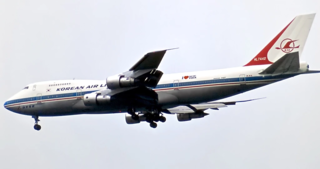
Korean Air Lines Flight 007 (KE007/KAL007) was a scheduled Korean Air Lines flight from New York City to Seoul via Anchorage, Alaska. On September 1, 1983, the flight was shot down by a Soviet Sukhoi Su-15 interceptor. The Boeing 747 airliner was en route from Anchorage to Seoul, but owing to a navigational mistake made by the crew, the airliner drifted from its original planned route and flew through Soviet prohibited airspace. The Soviet Air Forces treated the unidentified aircraft as an intruding U.S. spy plane, and destroyed it with air-to-air missiles, after firing warning shots. The Korean airliner eventually crashed into the sea near Moneron Island west of Sakhalin in the Sea of Japan. All 269 passengers and crew aboard were killed, including Larry McDonald, a United States representative. The Soviet Union found the wreckage under the sea two weeks later on September 15 and found the flight recorders in October, but this information was kept secret by the Soviet authorities until 1992, after the country's collapse.

The USAF Air Demonstration Squadron ("Thunderbirds") is the air demonstration squadron of the United States Air Force (USAF). The Thunderbirds are assigned to the 57th Wing, and are based at Nellis Air Force Base, Nevada. Created 71 years ago in 1953, the USAF Thunderbirds are the third-oldest formal flying aerobatic team in the world, after the French Air Force Patrouille de France formed in 1931 and the United States Navy Blue Angels formed in 1946.

The Boeing B-47 Stratojet is a retired American long-range, six-engined, turbojet-powered strategic bomber designed to fly at high subsonic speed and at high altitude to avoid enemy interceptor aircraft. The primary mission of the B-47 was as a nuclear bomber capable of striking targets within the Soviet Union.
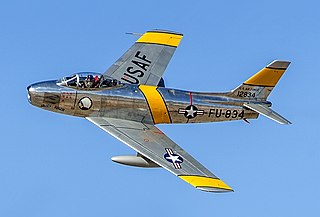
The North American F-86 Sabre, sometimes called the Sabrejet, is a transonic jet fighter aircraft. Produced by North American Aviation, the Sabre is best known as the United States' first swept-wing fighter that could counter the swept-wing Soviet MiG-15 in high-speed dogfights in the skies of the Korean War (1950–1953), fighting some of the earliest jet-to-jet battles in history. Considered one of the best and most important fighter aircraft in that war, the F-86 is also rated highly in comparison with fighters of other eras. Although it was developed in the late 1940s and was outdated by the end of the 1950s, the Sabre proved versatile and adaptable and continued as a front-line fighter in numerous air forces.

The Convair B-36 "Peacemaker" is a strategic bomber that was built by Convair and operated by the United States Air Force (USAF) from 1949 to 1959. The B-36 is the largest mass-produced piston-engined aircraft ever built. It has the longest wingspan of any combat aircraft ever built, at 230 ft (70 m). The B-36 was the first bomber capable of delivering any of the nuclear weapons in the U.S. arsenal from an internal bomb bay without aircraft modifications. With a range of 10,000 mi (16,000 km) and a maximum payload of 87,200 lb (39,600 kg), the B-36 is capable of intercontinental flight without refueling.
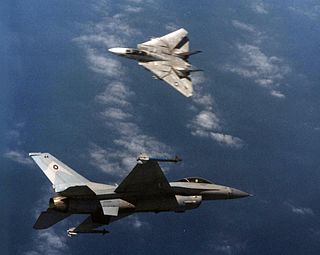
A dogfight, or dog fight, is an aerial battle between fighter aircraft conducted at close range. Modern terminology for air-to-air combat is air combat manoeuvring (ACM), which refers to tactical situations requiring the use of individual basic fighter maneuvers (BFM) to attack or evade one or more opponents. This differs from aerial warfare, which deals with the strategy involved in planning and executing various missions.
This is a list of aviation-related events from 1955.
This is a list of aviation-related events from 1964.

The North American Sabreliner, later sold as the Rockwell Sabreliner, is an American mid-sized business jet developed by North American Aviation. It was offered to the United States Air Force (USAF) in response to its Utility Trainer Experimental (UTX) program. It was named "Sabreliner" due to the similarity of the wing and tail to North American's F-86 Sabre jet fighter. Military variants, designated T-39 Sabreliner, were used by the USAF, United States Navy (USN), and United States Marine Corps (USMC) after the USAF placed an initial order in 1959. The Sabreliner was also developed into a commercial variant.
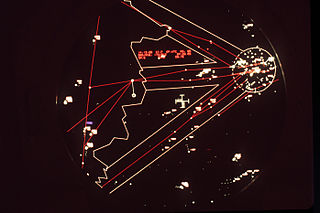
During the Cold War era (1945–1991), the West Berlin air corridors, also known as the Berlin corridors and control zone, were three regulated airways for civil and military air traffic of the Western Allies between West Berlin and West Germany passing over East Germany's territory. The corridors and control zone were physically centered on and under control of the all-Allied Berlin Air Safety Center (BASC) in West Berlin. The airspace within these corridors was used by US, UK and French-registered non-combat aircraft belonging to these countries' armed forces and airlines operated by pilots holding those countries' passports. In addition, it was also used by LOT Polish Airlines for regular scheduled services from Warsaw to London and Paris via Schönefeld Airport to the south of East Berlin.

Training Squadron EIGHT SIX (VT-86), also known as the "Sabrehawks," is a United States Navy advanced jet training squadron based at the Naval Air Station Pensacola, Florida. Training Squadron 86 is a tenant command of Training Air Wing 6. They are a training squadron flying the T-45C Goshawk. Their tailcode is F and their radio callsign is ROKT.

The Boeing B-52 Stratofortress is an American long-range, subsonic, jet-powered strategic bomber. The B-52 was designed and built by Boeing, which has continued to provide support and upgrades. It has been operated by the United States Air Force (USAF) since the 1950s, and NASA for over 40 years. The bomber can carry up to 70,000 pounds (32,000 kg) of weapons, and has a typical combat range of around 8,800 miles (14,200 km) without aerial refueling.

The 1961 F-84 Thunderstreak incident, occurring on 14 September 1961, was an incident during the Cold War, in which two Republic F-84F Thunderstreak fighter-bombers of JaBoG 32 of the German Air Force (Luftwaffe) crossed into East German airspace because of a navigational error, before landing at Berlin Tegel Airport. The two planes successfully evaded a large number of Soviet fighter planes by finding cover in a heavy layer of clouds, but also by the actions of an airman at the United States Air Force (USAF) air route traffic control center at Berlin Tempelhof Airport who ordered the planes on to Berlin rather than forcing them to turn around and face the pursuing fighter planes. The event came at a historically difficult time in relations between West Germany and East Germany. Only a month before, the Berlin Wall had been built, which completely cut off West Berlin from surrounding East Germany and from East Berlin. It also came three days before the West German federal election, held on 17 September 1961.



